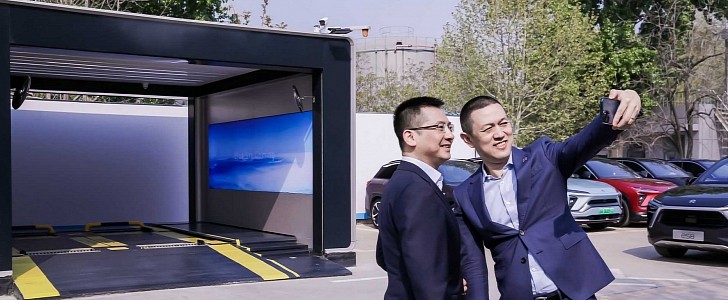One of the major selling points for Tesla is its Supercharging network. The ability to make road trips and easily charge these EVs anywhere earned the company multiple customers. However, things can get ugly on holidays, with long lines forming in some Supercharger stations. NIO has started to face something similar in China.
On China’s National Day holiday Golden Week, from October 1 until October 7, complaints about queues both on battery swap stations and fast-charging stations emerged on Chinese social media. NIO’s CEO, William Li, talked about that in an interview during the China Cybersecurity Week.
According to CNEVPost, Li said that the issue was the accelerating pace of EV adoption in China, making the current charging infrastructure insufficient for all the new cars reaching the streets.
The NIO CEO said that the company invested in expanding both its battery swap stations and the fast chargers to help ease the situation in national holidays. NIO customers would be “relatively happier” thanks to those investments.
The company released its numbers during the Chinese holidays. According to NIO, its battery swap stations swapped 130,938 times from October 1 until October 7. Of all these, 27,581 were done at highway service areas. Regarding fast charging sessions, NIO stated they were 104,136 during the same period.
An interesting aspect was how much time each NIO owner spent on battery swap stations on average. From scheduling the swap until completing it, they have waited 14 minutes and 6 seconds on average. When you consider that’s what they had to wait to get a fully charged battery pack, NIO’s system proves once again to be the most convenient one.
The problem is that NIO will have to invest as much in factories and increasing its sales numbers as it will have to care about battery swap stations. After all, this technology is also a central sales point for the company.
According to a recent report from Yu Xiaoli, a business analyst from Industrial Securities, NIO is in an excellent position to expand its battery-swapping services. In her calculations, NIO spends about RMB2.5 million ($388,918 at the current exchange rate) to build each of its second-generation battery swap stations. Each of these stations can handle 312 swaps per day.
With that in mind, she believes NIO will spend RMB7.5 billion ($1.17 billion) to reach 3,000 battery swap stations in China by 2025. The company had RMB48.3 billion (about $7.514 billion) in cash and equivalents at the end of Q2 2021. According to the analyst, that ensures NIO can enlarge its charging network with no pressures. With these numbers, we hope it invests even more in expanding. That will prevent its customers from having to wait too much even on holidays.
According to CNEVPost, Li said that the issue was the accelerating pace of EV adoption in China, making the current charging infrastructure insufficient for all the new cars reaching the streets.
The NIO CEO said that the company invested in expanding both its battery swap stations and the fast chargers to help ease the situation in national holidays. NIO customers would be “relatively happier” thanks to those investments.
The company released its numbers during the Chinese holidays. According to NIO, its battery swap stations swapped 130,938 times from October 1 until October 7. Of all these, 27,581 were done at highway service areas. Regarding fast charging sessions, NIO stated they were 104,136 during the same period.
An interesting aspect was how much time each NIO owner spent on battery swap stations on average. From scheduling the swap until completing it, they have waited 14 minutes and 6 seconds on average. When you consider that’s what they had to wait to get a fully charged battery pack, NIO’s system proves once again to be the most convenient one.
The problem is that NIO will have to invest as much in factories and increasing its sales numbers as it will have to care about battery swap stations. After all, this technology is also a central sales point for the company.
According to a recent report from Yu Xiaoli, a business analyst from Industrial Securities, NIO is in an excellent position to expand its battery-swapping services. In her calculations, NIO spends about RMB2.5 million ($388,918 at the current exchange rate) to build each of its second-generation battery swap stations. Each of these stations can handle 312 swaps per day.
With that in mind, she believes NIO will spend RMB7.5 billion ($1.17 billion) to reach 3,000 battery swap stations in China by 2025. The company had RMB48.3 billion (about $7.514 billion) in cash and equivalents at the end of Q2 2021. According to the analyst, that ensures NIO can enlarge its charging network with no pressures. With these numbers, we hope it invests even more in expanding. That will prevent its customers from having to wait too much even on holidays.











